History Artefact boxes available to hire
Our artefact boxes are designed to enrich history lessons and engage pupils. They are linked to National Curriculum programmes of study for Key Stages 1–3.
Please ensure you read our terms and conditions of loan before ordering.
Call us on 01962 874802 to check box availability before completing our Curriculum Centre order form.
Charges
Subscribing schools can order our boxes at discounted rates:
- £25 for 1 week
- £40 for 2 weeks
- £50 for 3 weeks
Non-subscribing schools will incur an additional charge of £35 per loan.
VAT will apply for non-Hampshire schools
Key stage 1
Within and beyond Living memory
 |
|||
Toys, games and pastimes and Changing toys, games and pastimesA selection of toys that have been popular through the years, this collection will allow children to explore the toys that the people in their lives may have played with and how they are different or similar to their own toys. Changing toys also includes a selection of toys through time, however this collection includes some matched items to explore the concept of change and continuity in a more explicit way. |
Holidays within living memoryHow have family holidays changed? This collection explores the kinds of holidays families have taken since the 1950’s/60’s, by looking at the items they packed and the souvenirs that they brought home. How does this compare to your holiday? |
Home life within living memoryHow has our home changed? What sort of things did we use in our homes to keep them clean and do the cooking? What furniture might we have found in homes that the grown ups we know would have had as children. These artefacts can also be used to create a home corner from the past with guided role play and tasks. |
Changing technologyPossible KS2 thematic study Technology is an area where there has been massive change within our living memories. This collection explores how technology that children may be familiar with has developed over time. The collection focuses on the following areas, household, cameras, telephones, music, and writing using artefacts and images. Ideal for creating timelines. Images and a timeline are also supplied to look at transport. |
|
|
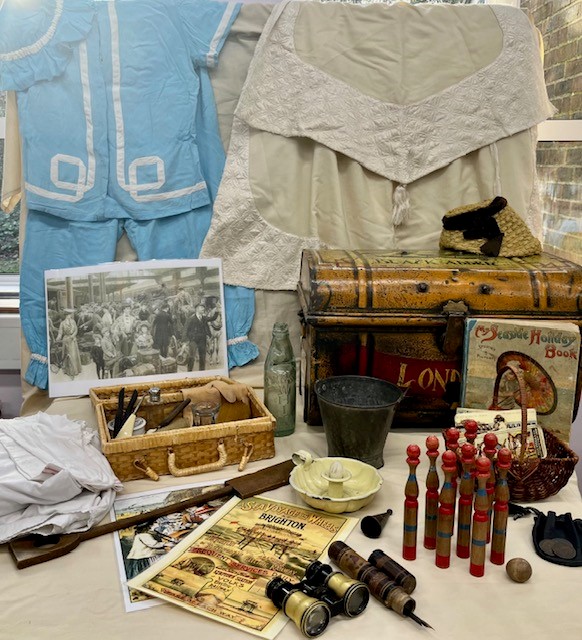 |
||
How school life has changedStarting with the Victorian era when school became a universal right and continuing to the 1990’s this collection looks at items that you commonly found in schools through this time, the artefacts and materials allow children to question the grown ups in their lives what was school like for you. |
Victorian SchoolsHow old is your school? Many Hampshire schools date back to the Victorian era; this artefact collection can be used to step back in time and see what children would have experienced when school was first introduced for all. |
Victorian seasidePossibly for KS2 local With the help of an included lively story of a Victorian family’s beach holiday, unpack the trunk of artefacts and explore the items as they are mentioned in the story. Do you recognise any of the items? How are they different to what you may take to the beach today? |
Victorian home lifeWith the help of an included lively story, explore the belongings of a rich Victorian family and their servants. What are the items, how were they used and who used them? The story helps you answer these questions. How is this different to how the children live today? |
 |
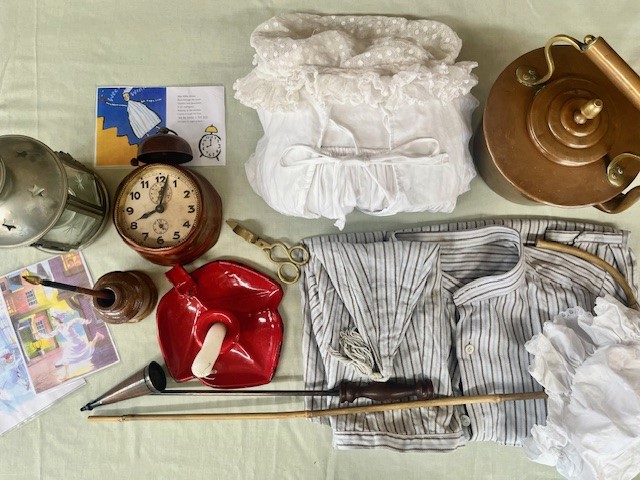 |
||
Castle lifeTurn your classroom into a medieval castle during a banquet, from the wall hangings to the cooking equipment, and table ware. Recreate making a banquet fit for the lord and lady. |
Nursery Rhymes boxIdeal for EYFS to begin to use items to explore history by illustrating 5 traditional nursery rhymes, including Polly put the kettle on, Jack and Jill and Mary had a little lamb. Use the artefacts to create fun and practical activities that encourage the curiosity of the children and lead them on their first steps into the past. |
|
|
Key stage 1
Significant past events
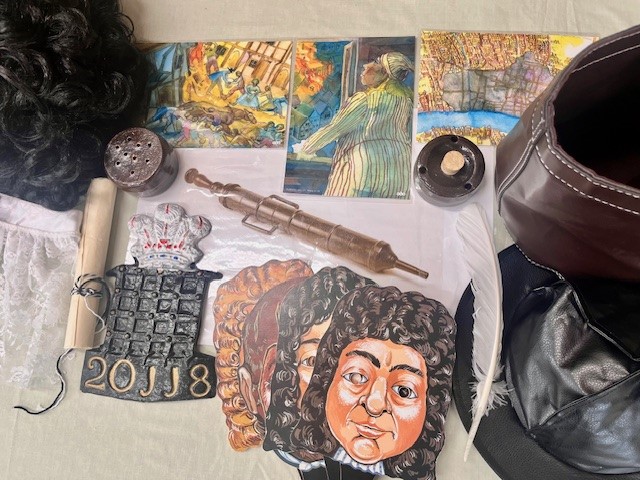 |
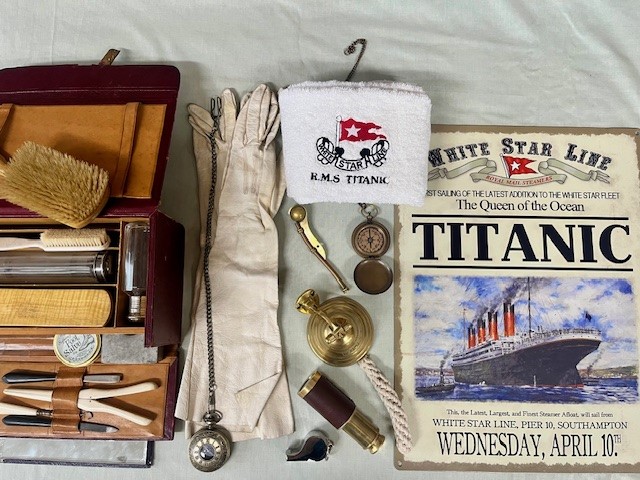 |
||
Great Fire of London resourcesExplore the details of the fire through a timeline story, maps, artefacts and other resources. How well does a bucket chain/ squirt work? How would things be different today? |
TitanicAlso for KS2 local study Explore and solve this history mystery of an event which has many local links. Who owned the mysterious trunk and where were they going? There are also many other resources to assist the exploration of the causes of the tragedy of the sinking of the Titanic. |
WW2 evacueesAlso for KS2 local study Explore what life would have been like for the children and their teachers/ carers who were evacuated during WW2, by unpacking a set of suitcases of items that they took with them from their home to their evacuee family. What would the children take today? How is this different? |
WW2 Home FrontAlso for KS2 local Brings to life a study of life on the home front during the Second World War. What was life like for the person who owned this suitcase? What kind of jobs were they doing to help with the war effort at home? |
 |
|||
World War IUsing the artefacts to explore the kit and lives of service personnel in the First World War and look at how we remember this significant event from beyond living memory. |
|
|
|
Key stage 1
Significant individuals
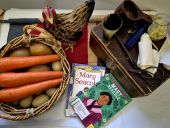 |
|||
Mary AnningExplore the life and work of a young girl who discovered the first full fossilized remains of an ichthyosaur, plesiosaur and a pterodactyl by exploring the items she would have use. Why did it take so long to recognise her achievements? |
Queens: lives and timesCostume and role play items join artefacts relating to Elizabeth I, Queen Victorian and Elizabeth II to help pupils compare their lives and what life was like for their subjects at the times they lived, particularly in relation to all forms of communication, clothing, portraits and commemorating events. |
QFlorence NightingaleChildren try to work out to whom the mystery trunk belongs, using the objects within they will encounter evidence of her work and legacy as they do. They will also be able to compare to what they may know of the work of nurses today and how Florence Nightingale still has an impact. |
Mary SeacoleAt the time of the Crimean War Mary Seacole was working as a nurse at the same time as Florence Nightingale, what can we tell about her life and work from the objects in this collection. Explore how her life differed from Florence Nightingale and how she became forgotten for a period of time before being recognised as the greatest Black Briton. |
Key stage 2
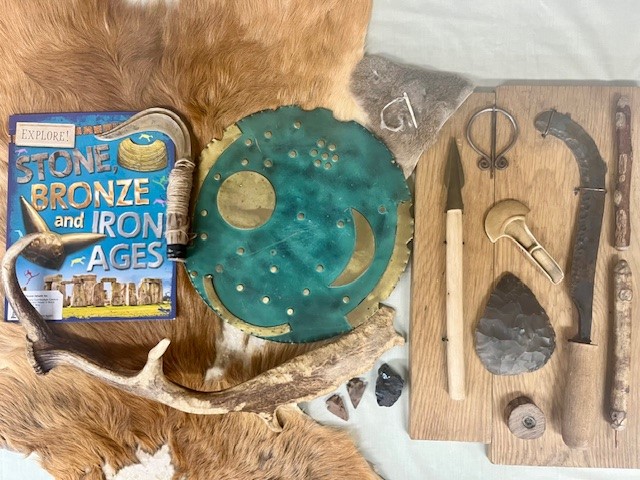 |
 |
 |
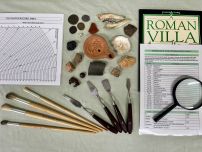 |
Stone, Bronze and Iron AgeExplore the tools and weapons people who lived so long ago managed to make from the very limited range of natural resources available to them. The artefacts also encourage exploration of the technological changes that took place across these three time periods. |
Roman soldiers: fighters or builders?Explore the pivotal role the Roman army played in the ‘Romanisation’ of Roman provinces like Britannia. Using the artefacts to explore what kit a soldier had and why they were nicknamed ‘Marius’ Mules’. |
Life in Roman BritanniaUsing a selection of artefacts to demonstrate what the lifestyles of Britons and Romans/Romano Britons looked like and answer the question whether Roman innovations and introductions impacted everyone or outlasted the Roman occupation. |
Roman villa excavation boxDesigned to create a mock excavation of a Roman villa site. The collection features the sort of fragmentary items that would be found during such a dig. Designed to teach about how historians and archaeologists work and how we know about the Romans from the pieces they left behind. |
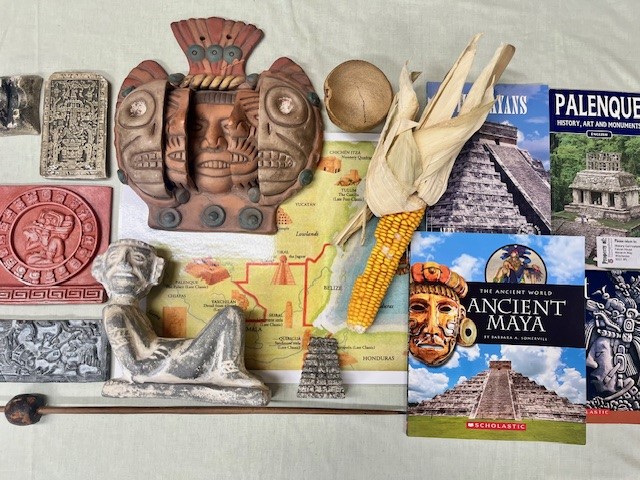 |
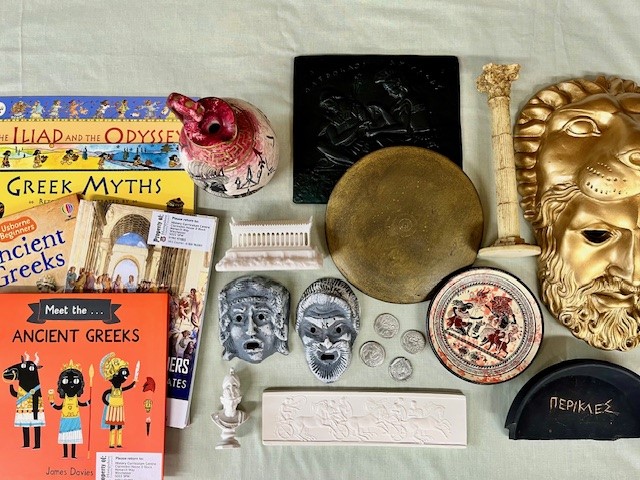 |
||
Mayan resources boxExplore this mysterious civilization through artefacts, books and other resources that illustrate aspects of Mayan life, knowledge and beliefs. |
Anglo-Saxon Life through DeathExplores what grave goods can tell us about Saxon life and culture, including men’s and women’s roles. The activities contained in the box also demonstrate the conversion from paganism to Christianity by examining changing burial practices during this period. |
Viking Life boxExplores aspects of Viking life and culture such as war and conflict, daily life, beliefs using a selection of artefacts and resources. How did this culture spread so far from Scandinavia? |
Ancient Greek boxThe artefacts Illustrate many aspects of ancient Greek life, their achievements and their influence on us today, from mathematics, philosophy, politics, justice and theatre to religion, medicine and the Olympics. |
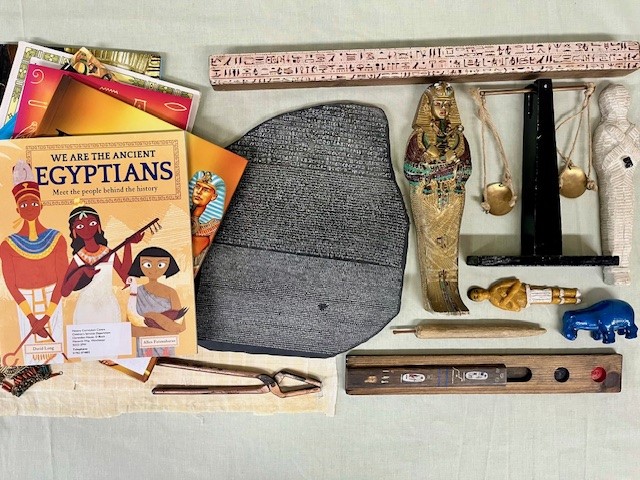 |
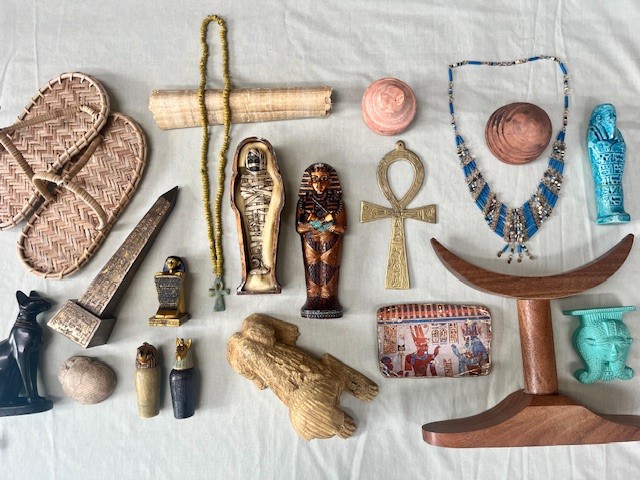 |
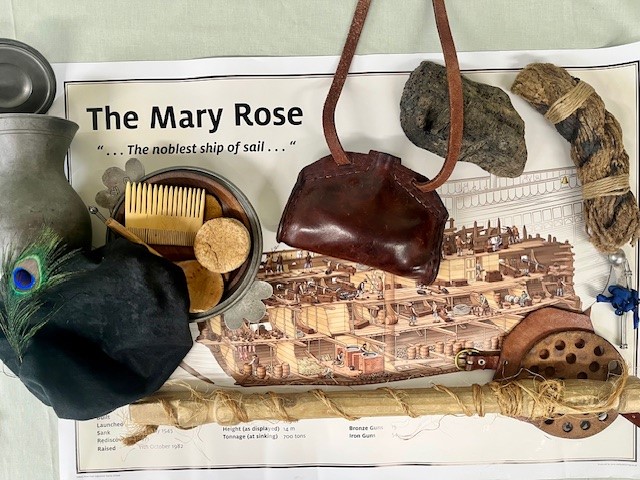 |
 |
Ancient Egyptian AchievementsThis collection asks pupils to decode evidential images from real Egyptian tombs and match them to replica artefacts to see what they tell us about Egyptian technology and other achievements. |
Ancient Egypt tombThe artefacts in this box can be used to recreate the experience of opening a tomb from Ancient Egypt. What do the items tell us about the life of the person who owns this tomb? Can the children solve the mystery of who they were? |
Mary RoseThis collection of artefacts has been loaned to us from the Mary Rose Museum and are replicas of the real items found on board alongside real pieces of wood and rope from the shipwreck. They can be used to explore what life was like on board for both officers and sailors in this Tudor time capsule. |
Stone Bronze and Iron Age digDesigned to create a mock excavation in a sand tray of a Stone, Bronze and Iron age site. The collection features the sort of items that would be found during such a dig. Designed to teach about how historians and archaeologists work and how we know about these people from the pieces they left behind. |
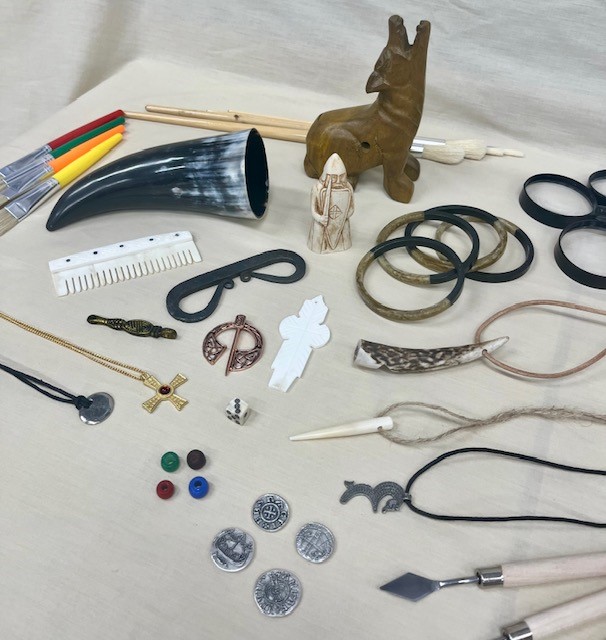 |
|||
Viking digDesigned to create a mock excavation in a sand tray of a Viking site. The collection features the sort of items that would be found during such a dig. Designed to teach about how historians and archaeologists work and how we know about these people from the pieces they left behind. |
Anglo Saxon dig – new box, coming soonDesigned to create a mock excavation in a sand tray of an Anglo-Saxon site. The collection features the sort of items that would be found during such a dig. Designed to teach about how historians and archaeologists work and how we know about these people from the pieces they left behind. |
|
Key stage 2
Local, post 1066 and thematic studies
 |
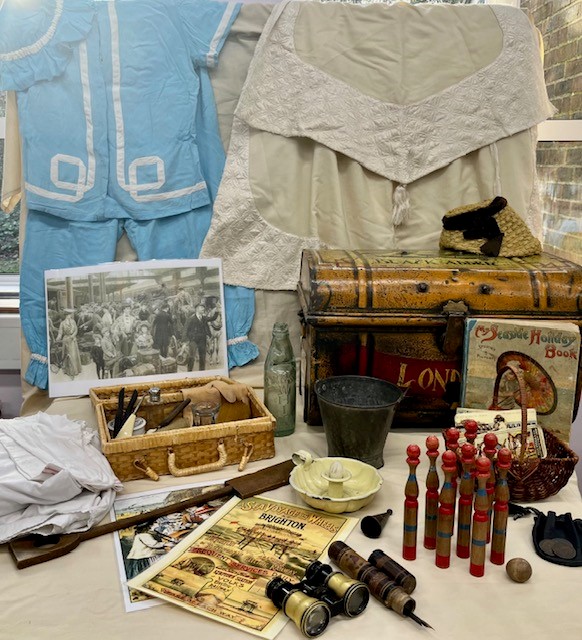 |
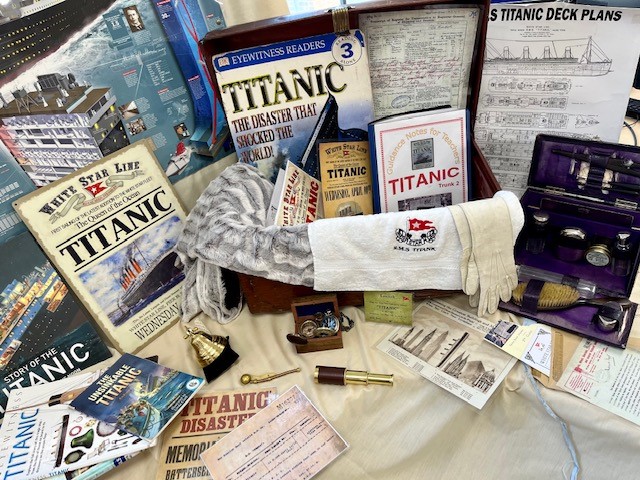 |
|
Life in Tudor timesExplores different aspects of Tudor life using artefacts from the period, looking at coins, portraits, tableware, religious items as well as personal object. The artefacts help to explore what life was like for those in this period. |
Victorian schoolsHow old is your school? Many Hampshire schools date back to the Victorian era; this artefact collection can be used to step back in time and see what children would have experienced when school was first introduced for all. |
Victorian seasideWith the help of an included lively story of a Victorian family’s beach holiday, unpack the trunk of artefacts and explore the items as they are mentioned in the story. Do you recognise any of the items? How are they different to what you may take to the beach today? |
Titanic trunkExplore and solve this history mystery of an event which has many local links. Who owned the mysterious trunk and where were they going? There are also many other resources to assist the exploration of the causes of the tragedy of the sinking of the Titanic. |
World War II evacueesExplore what life would have been like for the children and their teachers/ carers who were evacuated during WW2, by unpacking a set of suitcases of items that they took with them from their home to their evacuee family. What would the children take today? How is this different? |
World War II home frontBrings to life a study of life on the home front during the Second World War. What was life like for the person who owned this suitcase? What kind of jobs were they doing to help with the war effort at home? |
|
|
Key stage 2
Other
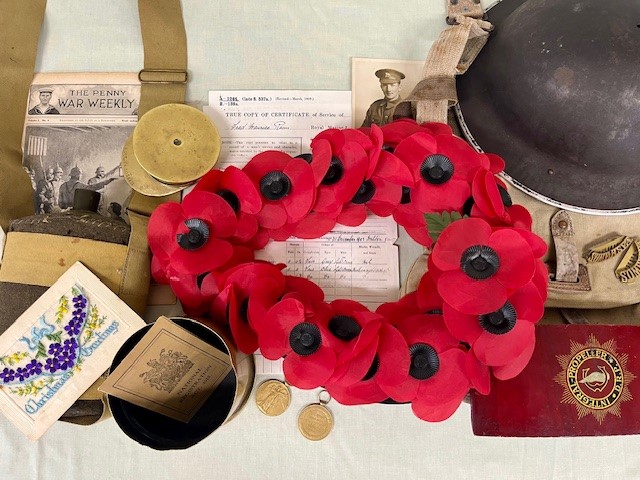 |
|||
World War IUsing the artefacts to explore the kit and lives of service personnel in the First World War and look at how we remember this significant event from beyond living memory. |
|
|
